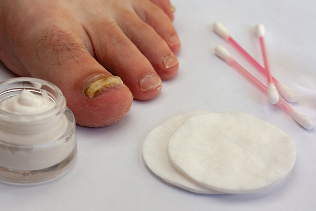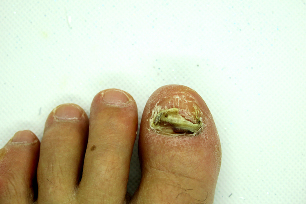The fungus toe is a problem troubling many. Itching, burning and unsightly skin and nails – this is only a small part. The disease is dangerous the complications that cure even more difficult. However face a problem, you can, if you take seriously the treatment of fungal infections (mycoses).

Why fungus of the feet?
Mushrooms – this is one of the types of infectious agents that affect the skin. It is difficult to be arranged and is extremely robust micro-organisms. Therefore, fungal diseases and require a multidisciplinary approach for the treatment.
The mushrooms have their favorite places of the habitat on the skin. First of all, it is the skin of the fingers of the feet and nails. The reason is clear – the feet are usually inside shoes, inside of which accumulates a lot of moisture and dirt, but also very hot. This is why in the fungi that live on the feet, plenty of food and a favorable microclimate for breeding. Certain types of complexes of fungi most often strike the skin, and other types of fungi, e.g., yeasts and molds, prefer nail plate. May be the infection of several types of fungi.
Promote the development of fungi on the toes:
- reduces local and general immunity;
- poor hygiene stop;
- uncomfortable and tight shoes;
- not to change the socks or the bottom;
- the wearing of socks or the bottom of synthesis, disclosing the air materials;
- regular of hypothermia or overheating of the feet;
- the circulatory disorders in the legs;
- varicose veins;
- the chronic diseases of the cardio-vascular system, diabetes mellitus;
- the long course of an antibiotic treatment;
- the increased sweating of the feet;
- the lack in the body of vitamins and minerals;
- the mechanical damage of the skin, of corn, of an injury judgment;
- excess body weight, excessive physical activity on the feet;
- not brushing of the nails on the feet.
The most important of these factors – reduction of immunity, and circulatory problems in the legs. Decreased immunity can occur for different reasons. Usually, this is a heavy chronic diseases, first of all, infectious diseases. Also, immunity can decrease as a result of HIV, receiving immunosuppressive drugs, by cancer. Not of least importance and a breach of the blood circulation in the fingers of feet because of the vascular disease, blood, diabetes, smoking.
Thrush stop can develop in men and women. In adults, they occur most often in children.
Some types of fungi live constantly on the skin and are only accepted in unfavorable circumstances, for example, fungi of the genus Candida. But other species are transmitted from person to person. The contamination may occur during the visit to the gym, bathroom, shower, if this person does not exercise personal shoes. Also considerably the risk of infection is expose the people who ill-omen shoes of someone else, or socks, or giving to other people to use. Often, the infection occurs when you use the same towels, accessories, manicure, etc., are Factors that increase the likelihood of contracting – cuts on the surface of the skin, the deformation of the nail plate.
The symptoms of fungus on your toes
The main symptoms of athlete's foot – itching and burning. You may also experience redness of the skin, small blisters, scaling and roughness of the skin, a unpleasant smell. The first symptoms of the fungal infection of the skin can be confused with simple irritation.
The symptoms of onychomycosis
The fungus can affect not only the skin but also the nails. The latest variant of the fungal infection called onychomycosis. The main symptom of onychomycosis the change in the structure and appearance of the nail of his increasing fragility. The nail becomes yellow, on its surface appear grooves and cracks, the nail plate thickens and deforms. If they did not attend treatment, the nail will gradually flake off the nail bed and crumble.
Looks like the fungus on the finger: picture
It is not necessary to put you to self-diagnose, according to the pictures. The diagnosis must be qualified by a dermatologist.
Only he will be able to determine the type of fungus. To do this, it may happen that it is not only an external inspection of the feet, but also testing of laboratories, dermatological, scratching.

However, signs even from a distance, look like shown in the photos is the occasion for the anxiety and the consultation of the physician.
The treatment of a complex disease and it takes place at home under the supervision of a doctor.
Fungus on the little finger
The fungus can strike the skin of the fingers of the feet. But the ear on the leg are the most vulnerable to the infection. The little finger, in tight shoes often reduced, because of what on the skin will produce scratches and the disorders of circulation. When the defeat of the nail of the little finger of the disease develops very rapidly, more rapidly than any other nail. During infection ear infection very quickly can touch and the other fingers.
The fungus on the little finger of the leg is treated as a fungus in other areas of the skin. In the onychomycosis of the nail of the little finger of the more rational, the output can be the elimination of the plate. This operation will not bring a lot of inconvenience to the patient, because the nail of his little finger develops quickly. However, until the nail is never really returned to again (this may take 3-4 months), it is necessary to use antifungal drugs for the prevention of reinfection.
Rather than treat the fungus toe?
The treatment of the fungus should begin as soon as the first symptoms. In the first place, it is necessary to consult a dermatologist for a diagnosis. Before you start the treatment, you need to install the fact of the presence of yeast and the sight of the pathogens. To this end, the doctor will take a scraping of the skin or cut a piece of a nail (upon the defeat of the nail). Waive blood tests, blood sugar. Fungal infections of the skin of the feet is necessary to differentiate between:
- other infectious diseases of the skin;
- allergic reactions;
- dermatitis, caused by diabetes, vascular disease, stress and diseases of the nervous system.
For the treatment of fungal infections of the feet the most often used are the local tools (sprays, ointments, creams). Only in severe cases, the doctor may prescribe an antifungal pill. The most frequently used tablets of fluconazole, along with itraconazole, terbinafina.
The treatment is based on the use of these funds. This type of medication contains substances that kill fungi (fungicidal) or stopping their reproduction.
Apply also to local products with antibacterial properties, anti-inflammatory and keratolytic properties. The antibacterial agents are appointed in this case, if suppuration occurs, it is a fungal infection joins bacterial. The anti-inflammatory drugs well with the unpleasant symptoms – itching and burning. But they do not affect the cause of the disease – pathogens. The keratolytic means are of zinc, sulphuric acid and sulphuric-salicylic ointments. They accelerate the regeneration of skin tissue by speeding up exfoliation of the victim of the epidermis.
For the treatment of fungal infections stop also apply baths with antiseptic means – a solution of potassium permanganate, iodine, salt, baking soda, boric acid. The bowls better do it before bed for 20 minutes. To prevent infection by the spores need to treat the area of healthy skin chlorhexidine, iodine, hydrogen peroxide, potassium permanganate. For the treatment of onychomycosis are used varnish antimycotic dangerous. These coatings must be applied on the nail plate.
Ointments and creams must be previously washed and clear skin at the frequency specified in the instructions of the tool. The area of application of the ointment should be a little more of the visible area of the defeat. For application on nail plate nail Polish, you need to steam, the jagged edges of his sanded lime, and the surface of the nail degrease the alcoholic solution.
In the popular medicine to get rid of fungal infections of the feet are used with decoctions of medicinal plants chamomile, calendula, sage, st. john's wort, mint, sauce of vinegar, onions and lemon juice.
What to do if the fungus on the finger does not pass?
The treatment of mycosis long and difficult process. The micro-organisms fungal very tenacious, and a couple of days to get rid of them is impossible. Need sometimes of many months of extensive therapy. You can't interrupt the treatment for one day only. The treatment of onychomycosis cannot be completed, until, that is never really returned to new, the preservation of the nail plate.

It is important to take into account also other factors, related to the development of the disease. The lack of hygiene of the skin and optimal temperature shutdown can negate all of the therapeutic efforts. This means that you must regularly wash the surface of the skin of the feet, prevent overheating or hypothermia. It is also important to avoid mechanical damage of the skin, an excessive load on the feet, cuts and wounds. Excess weight increases the pressure on your feet, so if you suffer from fullness, it is necessary to think to lose weight.
If the patient is constantly at the door infected by a fungus, the shoes, then it does not help any of the powerful drugs, because the place of the dead micro-organisms here to occupy new. This is why you need to get rid of all the factors of recycling of the infection. You can't walk in another's shoes, socks. The socks should be washed thoroughly and changed regularly. Inside of the shoe should be carefully a spray anti-fungal means.
When the thrust washer at the athlete's foot, you need to analyze the general state of health. May be this can help you identify the causes of the violation of the immunity and the blood circulation in the legs. Therefore, it is possible, it is necessary to undergo a thorough examination, and eliminate problems with the heart, blood, blood vessels, organs of the endocrine system.
Finally, it is not excluded that microorganisms simply have developed resistance to the used antimicrobial tool. It is then necessary to change medication. May be, you'll need to system anti-microbial drugs in the form of tablets. The dosage of drugs must choose a specialist dermatologist.
























